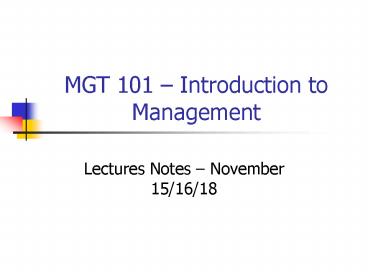MGT 101 Introduction to Management - PowerPoint PPT Presentation
1 / 24
Title:
MGT 101 Introduction to Management
Description:
COMMITTEE (Reps of Board and Medical Staff) MEDICAL STAFF (Chief of Staff) EXECUTIVE COMMITTEE (Chairs of all Committees & Chief of Staff) CREDENTIALS COMMITEE ... – PowerPoint PPT presentation
Number of Views:522
Avg rating:3.0/5.0
Title: MGT 101 Introduction to Management
1
MGT 101 Introduction to Management
- Lectures Notes November 15/16/18
2
Organizing as a management function
- Definition of Organizing
- Method for aligning the work and work processes
for effectiveness efficiency - Building Blocks of the organization
- Structure should reflect how organization
operates - Strategy
- Complexity of operations
- Company growth
- Relationships
- Accountabilities
- Work
3
Organizing as a management function (continued)
- Impact of structure As the organization changes,
the structure should change. - Major Aspects of Organizational Structures
- Departmentalization grouping of work activities
so that similar and logically related activities
occur together - Division of Work breakdown of tasks so that
each individual in the organization is
responsible for and performs a limited set of
activities rather than the entire task. - Levels of Management establishes hierarchy
- Chain of Command identifies managers and
subordinates and their relationships
4
Organizing as a management function (continued)
- The Building Blocks are designed upon answers
to these questions - What should units of organization be?
- What components or units should join together and
what ones should be kept apart? - What is the appropriate size of each unit?
- What is the appropriate placement and
relationships of different units?
5
Organizing as a management function (continued)
- Decide on the structure by examining
- Key Activites
- Contribution Analysis
- Four types of contribution
- Results Producing Activities (those that directly
provide services, build products, etc.) - Support Activities (those that help those
activities that provide services or build
products) - Hygienic/Housekeeping Activities (those necessary
to run an organization, including personnel,
bookkeeping, etc.) - Top Management Activities
6
Organizing as a management function (continued)
- Conscience Activities (Individuals setting
standards, working on vision, auditing
performance, etc. very few people in
organizations involved in this) - Service Staff
7
Organizing as a management function (continued)
- Rules of Organizing
- Never subordinate key activities to non-key ones.
- Never subordinate a revenue-producing activity to
a non-revenue producing one. - Never mix support activities with
revenue-producing activities.
8
Organizing as a management function (continued)
- Outcome of Organizing Organizational Chart
- Organizational Charts Visual of Structure
- They answer these questions
- Who am I (position in organization)?
- What do I do (organizational tasks and
functions)? - To whom am I accountable?
- Who is accountable to me?
- Who are they?
- What do they do?
- To whom are they accountable?
- Who is accountable to them?
9
Organizing as a management function (continued)
- Organizational Charts Tell You
- Communication
- Information Flow
- Status and Rank
- System of Appeals
- Pooled Authority
10
Creating an organizational chart
- Identify the FUNCTIONS of the positions and
levels by naming job functions, not people. - Correct Incorrect
- For those functions that represent a function
(secretary, unit clerk, etc.) which supports
another position (Vice President, Head Nurse,
etc.), use a horizontal line between the two
functions
Jane Smitherstein
Vice President
11
Creating an organizational chart
12
Creating an organizational chart
- For positions that represent a function which is
subordinate to (under) another function, use a
vertical line.
13
Creating an organizational chart
- When more than one positions represents functions
that are subordinate to another function, use a
combination of vertical and horizontal lines or
vertical lines.
14
Creating an organizational chart
- When functions within the organizational chart
are equal, place them on the same organizational
level.
15
Creating an organizational chart
- When a function is not equal to others on the
same level, but not subordinate to another
function on that level, place that function below
the other functions.
16
Creating an organizational chart
- Organizational charts may be represented
vertically. When shown vertically, the levels
descend from left to right.
17
Creating an organizational chart
- One form of organizational chart shorthand may be
employed using a wider and longer box to suggest
a number of individuals within one category
(staff, supervisors, aides, etc.)
18
Types of Structure
- Functional Structure
- Divisional Structure
- Division by Product or Service
- Division by Geography
- Division by Customer
- Matrix Division
19
Organization of Jobs
- Job Information
- Job Descriptions
- Job Specifications Knowledge, Skills, Abilities
- Job Structures
- Job Rotation
- Job Enlargement
- Job Enrichment
20
Dimensions of Organizational Design
Organizational Design
Organization structure
Integrating mechanisms
Locus of decision making
21
Chronological Development of Management
Perspectives
22
Tall versus Flat Structure
23
MIREE HOSPITAL, INC.
- INSURANCE VENTURES
- - HMO
- - PPO
- REAL ESTATE
- CORPORATION
- TECHNOLOGY CENTER
- BIOTECHNOLOGY
- CORPORATION
- CONSULTING CORPORATION
- -PRACTICE
- MANAGEMENT
- -TRAINING AND
- DEVELOPMENT
- FINANCIAL MANAGEMENT
- SERVICES
- ER AND TRAUMA SERVICES
- OPERATING ROOMS
- INTENSIVE CARE UNITS
- CORONARY CARE UNIT
- OUTPATIENT SURGICAL CENTER
- IN-SERVICE EDUCATION
- CERTIFICATION UNIT
- TRAINING
- STAFF DEVELOPMENT
- WOMENS SERVICES (OB/GYN)
- ONCOLOGY SERVICES
- PATHOLOGY MICROBIOLOGY
- RADIOLOGY SERVICES
- NUCLEAR MEDICINE
- PULMONARY MEDICINE
- PHYSIOTHERAPY
- PSYCHIATRY
- PEDIATRICS
- MEDICINE DEPARTMENTS
- OUT-PATIENT MEDICAL CLINICS
- NEIGHBORHOOD A CLINIC
- NEIGHBORHOOD B CLINIC
- NEIGHBORHOOD C CLINIC
- HOSPITAL CLINIC
24
MIREE HOSPITAL, INC.
BOARD OF DIRECTORS (Chairperson)
JOINT CONFERENCE COMMITTEE (Reps of Board and
Medical Staff)
MEDICAL STAFF (Chief of Staff)
EXECUTIVE COMMITTEE (Chairs of all Committees
Chief of Staff)
CREDENTIALS COMMITEE
INFECTION COMMITTEE
MEDICAL AUDIT COMMITTEE
PHARMACY AND THERAPEUTICS COMMITTEE
TISSUE COMMITTEE
UTILIZATION REVIEW COMMITTEE
RISK MANAGEMENT COMMITTEE































